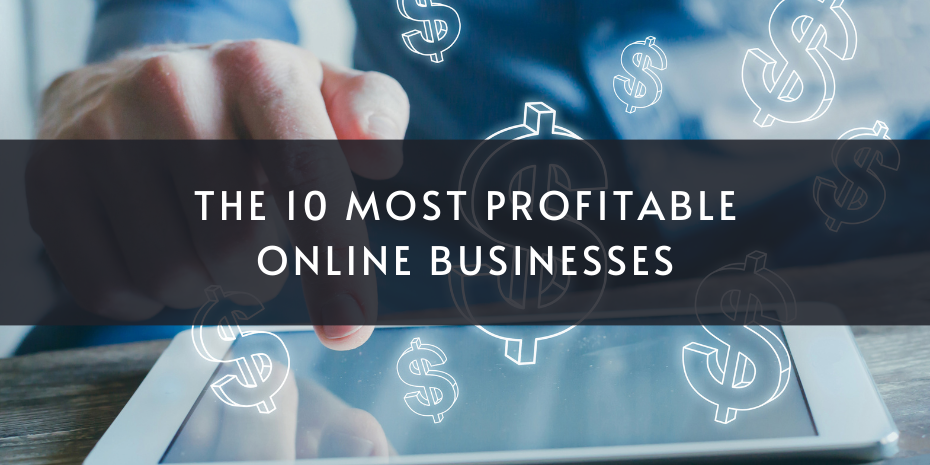In the dynamic landscape of the digital era, carving a niche for oneself and thriving in the online business realm has become a coveted pursuit. As entrepreneurs and freelancers seek lucrative opportunities, the possibilities seem boundless. In this guide, we delve into the realm of profitability, presenting the ten most lucrative online business ventures. From e-commerce giants to ingenious digital enterprises, these avenues not only promise financial gains but also offer the flexibility and scalability essential for the modern entrepreneur. Whether you're a seasoned professional or a novice, exploring these opportunities could be the catalyst for your online success.
1. E-Commerce

E-commerce has emerged as a highly profitable business model, fueled by the transformative impact of the internet on consumer behavior and global trade. One key factor contributing to its profitability is the unparalleled reach that online platforms provide. Traditional brick-and-mortar stores are limited by geographical constraints, whereas e-commerce transcends these boundaries, enabling businesses to tap into a vast and diverse global market. This expansive reach not only increases the potential customer base but also allows for targeted marketing strategies tailored to specific demographics and preferences.
Another crucial aspect of e-commerce profitability lies in its operational efficiency and cost-effectiveness. Online businesses can significantly reduce overhead costs associated with physical storefronts, such as rent, utilities, and in-store personnel. Additionally, the streamlined supply chain management facilitated by e-commerce platforms, coupled with the adoption of dropshipping models, minimizes inventory and fulfillment complexities. This operational agility translates into higher profit margins, providing businesses with the flexibility to invest in marketing initiatives, enhance customer experiences, and adapt swiftly to market trends.
Moreover, the data-driven nature of e-commerce platforms contributes to their profitability. Through sophisticated analytics and customer tracking tools, businesses can gain valuable insights into consumer behavior, preferences, and purchasing patterns. This data empowers e-commerce entrepreneurs to optimize their offerings, implement targeted marketing campaigns, and personalize the shopping experience. By leveraging these insights, businesses can enhance customer satisfaction, loyalty, and ultimately, revenue. The combination of global reach, operational efficiency, and data-driven strategies positions e-commerce as a highly lucrative and dynamic sector in the contemporary business landscape.
2. Affiliate Marketing

Affiliate marketing stands out as a highly profitable business model due to its ability to harness the power of collaborative partnerships and performance-based incentives. In this dynamic ecosystem, businesses can tap into a vast network of affiliates, leveraging their unique content creation and marketing skills to drive sales. The performance-based nature of affiliate marketing, where affiliates earn a commission for each sale or lead they generate, aligns the interests of both the merchant and the affiliate. This creates a win-win scenario, as affiliates are motivated to produce quality content that converts, while businesses benefit from a cost-effective marketing strategy with a direct impact on their bottom line.
One key factor contributing to the profitability of affiliate marketing is its scalability. Affiliate programs can attract a diverse array of affiliates, ranging from individual content creators to established influencers and niche bloggers. This scalability allows businesses to reach audiences that may be challenging to access through traditional marketing channels. For instance, the Amazon Associates program has been a pioneer in this space, allowing affiliates to promote a vast array of products on the world's largest e-commerce platform. The sheer diversity of products and the global reach of Amazon make it an attractive affiliate partner, illustrating how scalability contributes to the profitability of affiliate marketing.
De plus, la faible barrière à l’entrée pour les spécialistes du marketing affilié en fait une option accessible et rentable pour les personnes cherchant à monétiser leur présence en ligne. Les blogueurs, YouTubers et influenceurs des réseaux sociaux peuvent intégrer de manière transparente des liens d'affiliation dans leur contenu, monétisant ainsi leur audience sans avoir besoin de développement de produits ou de gestion des stocks. La polyvalence du marketing d’affiliation permet aux individus d’explorer diverses niches et de trouver des produits qui plaisent à leur public. Parmi les exemples de réussite notables en matière de marketing d'affiliation, citons le site d'évaluation technique Wirecutter, qui a été acquis par le New York Times, démontrant la rentabilité réalisable grâce à des partenariats d'affiliation stratégiques et à la création de contenu de qualité.
3. Online Education

Online education has become an immensely profitable business, driven by the increasing demand for flexible and accessible learning options. The scalability of online education allows businesses to reach a global audience without the constraints of physical infrastructure, making it a lucrative venture. Platforms like Udemy have democratized education by enabling instructors worldwide to create and sell courses, reaching millions of learners. The profitability stems from the ability to offer diverse courses at varying price points, catering to a broad spectrum of learners seeking personalized educational experiences.
Moreover, the advent of specialized online education platforms has fueled profitability by catering to niche markets. Coursera, for instance, partners with renowned universities and organizations to offer courses on specific subjects, providing learners with industry-recognized certifications. Skillshare focuses on creative skills, allowing instructors to monetize their expertise in areas such as design, photography, and writing. The profitability of online education is evident in the success of platforms like Khan Academy, which provides free educational content while generating revenue through partnerships and donations. The subscription-based model of MasterClass, offering exclusive lessons from industry experts, further exemplifies the profitability achievable in the online education sector. The combination of accessibility, scalability, and niche specialization contributes to the sustained success and profitability of online education businesses.
4. Freelance Services

Freelance services have emerged as a highly profitable business model, fueled by the evolving nature of work and the increasing demand for specialized skills. Platforms like Upwork and Fiverr connect businesses with a global pool of freelancers, allowing them to access a diverse range of talents without the overhead costs associated with traditional employment. The gig economy's rise has enabled freelancers to offer their expertise in areas such as graphic design, writing, programming, and marketing, providing businesses with cost-effective solutions to meet specific project needs. This flexibility benefits both parties, with freelancers enjoying the autonomy of choosing projects aligned with their skills and interests while businesses can tap into a dynamic talent pool on a project-by-project basis.
The profitability of freelance services is further underscored by the scalability it offers to both freelancers and businesses. Freelancers can take on multiple projects simultaneously, diversifying their income streams and potentially earning more than a traditional 9-to-5 role. Businesses, on the other hand, benefit from the ability to access specialized skills for short-term projects without the commitment of long-term employment. For instance, companies can hire a freelance web developer for a website redesign or a content creator for a specific marketing campaign. The success of platforms like Toptal, which connects businesses with top freelance talent in software development, exemplifies how freelance services can be a lucrative and efficient solution for businesses seeking expertise for short-term projects.
5. Print on Demand

Print on Demand (POD) has become a highly profitable business model, blending e-commerce with customization to meet the growing demand for unique and personalized products. Platforms like Printful and Printify enable entrepreneurs to create and sell custom-designed merchandise without the need for inventory or large upfront investments. This on-demand production model significantly reduces risks and costs associated with traditional retail, making it an accessible avenue for individuals and small businesses. Entrepreneurs can design and sell a diverse range of products, from custom t-shirts and mugs to phone cases, tapping into niche markets and leveraging trends for maximum profitability.
The profitability of Print on Demand is further amplified by its ability to cater to diverse and niche markets. Entrepreneurs can test various designs and products without the burden of holding inventory, allowing for agility and responsiveness to market preferences. Notable success stories in the Print on Demand space include businesses like Teespring, which empowers individuals to design and sell custom apparel, and Redbubble, an online marketplace connecting artists with consumers seeking unique, customized products. The success of these platforms underscores the profitability achievable through the combination of customization, on-demand production, and accessibility to a global customer base.
6. Virtual Assistance

Virtual Assistance has proven to be a highly profitable business as the demand for remote support services continues to grow. Entrepreneurs and businesses often seek virtual assistants to handle administrative tasks, customer support, and other specialized functions, allowing them to focus on core activities. Platforms like Time Etc. and Belay have capitalized on this trend, providing a marketplace where skilled virtual assistants connect with businesses seeking remote administrative support. The virtual assistance business model allows for flexibility, scalability, and cost-efficiency, as businesses can hire virtual assistants on-demand for specific projects or ongoing tasks, reducing the need for full-time, in-house staff.
Moreover, the virtual assistance industry's profitability is driven by its ability to cater to a diverse range of business needs. Virtual assistants can specialize in areas such as social media management, bookkeeping, or digital marketing, providing businesses with a tailored solution based on their requirements. This specialization enables virtual assistants to command higher rates for their expertise, contributing to the overall profitability of the business. Examples like Belay, which focuses on providing virtual assistants to busy executives and entrepreneurs, showcase how the virtual assistance business model not only meets the evolving demands of the modern workforce but also offers a lucrative opportunity for skilled professionals in various niche areas.
7. Subscription Box Services

Subscription box services have emerged as a highly profitable business model by combining the allure of surprise and convenience with curated, themed experiences delivered directly to customers' doorsteps. Businesses like Birchbox and Dollar Shave Club have not only capitalized on the recurring revenue model but have also created a loyal customer base. The subscription model ensures a predictable stream of income, as customers commit to receiving curated products regularly. This predictable revenue, coupled with the opportunity to cross-sell and upsell within the subscription box, contributes to the sustained profitability of these businesses.
Subscription box services have emerged as a highly profitable business model by combining the allure of surprise and convenience with curated, themed experiences delivered directly to customers' doorsteps. Businesses like Birchbox and Dollar Shave Club have not only capitalized on the recurring revenue model but have also created a loyal customer base. The subscription model ensures a predictable stream of income, as customers commit to receiving curated products regularly. This predictable revenue, coupled with the opportunity to cross-sell and upsell within the subscription box, contributes to the sustained profitability of these businesses.
8. Software as a Service (SaaS)

Software as a Service (SaaS) has become an exceedingly profitable business model due to its inherent advantages in scalability, cost-effectiveness, and accessibility. SaaS companies provide software solutions via the cloud, eliminating the need for users to install, maintain, and upgrade applications locally. This centralized model allows businesses to scale effortlessly, serving a growing user base without the need for extensive infrastructure investments. Examples like Salesforce, a cloud-based customer relationship management (CRM) platform, showcase the profitability of SaaS by offering businesses a flexible and scalable solution for managing their customer interactions. The subscription-based revenue model in SaaS ensures a steady stream of income, and regular updates and customer support contribute to customer retention, amplifying the long-term profitability of such ventures.
De plus, les entreprises SaaS bénéficient de la rentabilité de leur modèle de prestation. Les utilisateurs peuvent accéder aux applications logicielles via des navigateurs Web, éliminant ainsi le besoin d'installations complexes et réduisant les problèmes de compatibilité. Cette simplicité séduit les entreprises à la recherche de solutions efficaces sans le fardeau de la gestion de l'infrastructure logicielle sur site. Office 365 de Microsoft est un excellent exemple d'offre SaaS rentable, offrant aux entreprises une suite d'outils de productivité sur la base d'un abonnement. Le succès de ces géants du SaaS démontre comment la commodité, l'évolutivité et la rentabilité du modèle contribuent à une rentabilité durable dans le secteur concurrentiel du logiciel.
9. Dropshipping

Dropshipping has emerged as a highly profitable e-commerce business model, primarily due to its low barriers to entry, minimal upfront investment, and potential for significant profit margins. Unlike traditional retail models, dropshipping eliminates the need for businesses to hold inventory. Instead, products are shipped directly from suppliers to customers, reducing operational costs and the financial risks associated with unsold inventory. This asset-light approach enables entrepreneurs to start an e-commerce business with minimal capital, making it an accessible option for many.
One of the key reasons dropshipping is profitable lies in its flexibility and scalability. Entrepreneurs can easily test a wide range of products without committing to large quantities, allowing them to identify trending items and niche markets. Platforms like Oberlo and AliExpress have facilitated the dropshipping model, connecting entrepreneurs with suppliers globally. The ability to quickly adapt to changing market trends, offer a diverse product catalog, and optimize marketing strategies contributes to the sustained profitability of dropshipping businesses.
An illustrative example is the success of the fashion brand Fashion Nova. While not a traditional dropshipping model, Fashion Nova exemplifies the rapid adaptability and responsiveness to trends that are fundamental to dropshipping. By quickly identifying and sourcing trendy clothing items, Fashion Nova has grown into a major player in the fashion industry, demonstrating how a flexible, trend-driven approach can lead to profitability in the e-commerce landscape.
10. Digital Real Estate Investment

Digital real estate investment involves acquiring, developing, and selling virtual assets such as domain names, websites, or apps, and it has become a profitable business due to its potential for high returns, low entry barriers, and the increasing importance of the online presence. One significant factor contributing to the profitability of digital real estate is the scarcity of valuable digital assets. Premium domain names, for instance, are limited, and as the internet continues to grow, the demand for memorable, brandable domain names increases. Entrepreneurs who strategically invest in these assets can see substantial returns when selling to businesses looking for a strong online identity. For example, the domain 'Insurance.com' was sold for $35.6 million in 2010, highlighting the lucrative potential of digital real estate investments.
Furthermore, the rise of online businesses and the digital economy has elevated the value of well-established websites and apps. Investors can acquire, enhance, and monetize digital properties, benefiting from the income generated through advertisements, affiliate marketing, or subscription models. Successful examples include the acquisition of popular blogs or apps that cater to niche markets. Investors can optimize the user experience, implement effective monetization strategies, and later sell the enhanced digital property for a substantial profit. Flippa and Sedo are platforms where digital real estate transactions take place, showcasing the thriving marketplace for buying and selling online assets. The profitability of digital real estate investment lies in recognizing the intrinsic value of virtual assets and strategically positioning them in the evolving digital landscape.





